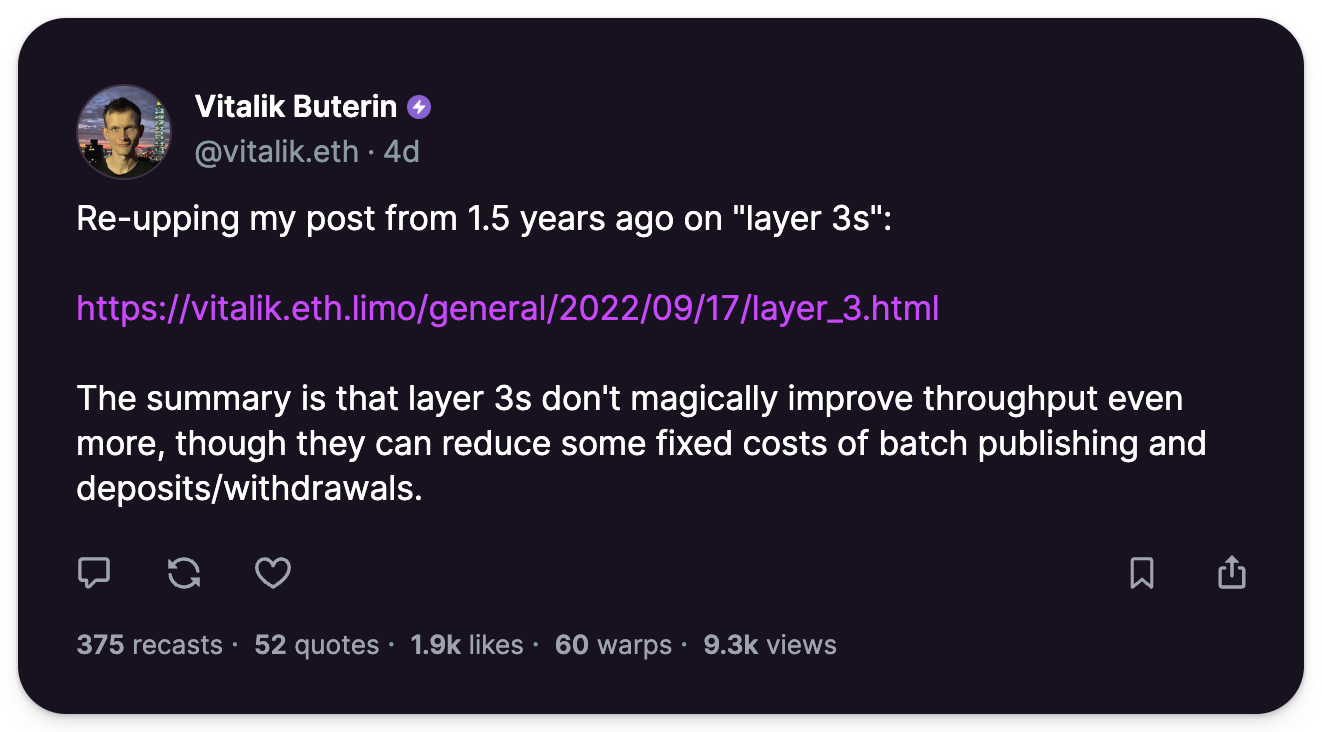Are Layer 3s the Future?

In the aftermath of Ethereum's Dencun upgrade, with fees down on most L2s, everyone is thinking about what comes next.
The scaling conversation has now rapidly shifted towards the potential next step — Layer 3s. L3s, which have also been called appchains, offer environments tailored to specific communities and use cases, such as enterprise blockchain applications or gaming.
Further, while Dencun generally reduced fees, we've yet to fully overcome the challenge, with gas prices on popular L2s like Base remaining a thorn in the side for many – though progress is being made.
Can L3s solve this problem?
How do we scale from here?
Examining the functions that L3s enable, the L3s currently deployed, and the frameworks available for launching them will provide more information to answer this question.
Median fees on Base were 700% higher than normal on Friday pic.twitter.com/4TjhMZGGEY
— ◢ J◎e McCann 🧊 (@joemccann) March 23, 2024
What do L3s offer?
Expanding from L2s to L3s allows for more specialized ecosystems tailored to specific needs, potentially broadening the blockchain market's reach significantly.
Successful L2s have established brands for themselves — i.e. Blast is the degen hub, Base is the consumer/social hub, Arbitrum is the DeFi/Gaming hub, and so on. In turn, the L3s they attract will most likely follow this cultural mold, maintaining the vibe onchain and further enhancing the Layer 2’s ability and reputation.
For example, L3s on Base may have a level of privacy needed to handle consumer data or be tailored towards a specific social use case. At the same time, L3s on Arbitrum could be specially equipped for gaming.
To do this, Layer 3s offer extensive customizability for augmenting these hubs and helping them scale through methods like:
- Reduced Settlement Costs: Settlement costs are greatly reduced, making development more economically viable.
- Arenas for Experimentation: The customizability of L3s provides the potential for endless experimentation, whether with new business models, different VMs, data availability solutions, or governance models — not possible on L1s or L2s.
- Privacy Enhancements: L3s can become privacy-centric layers, allowing for anonymous transactions or encrypted messaging services and opening the market to enterprise businesses that require this level of privacy.
- New Economic Models: L3s can develop new or more robust economic models where tokens other than ETH can be burned for gas, potentially increasing the value of that token over time.
L3s will create an isolated state environment and fee market for specific applications, letting them scale further while keeping interoperability with the broader onchain economy via L2
— Jesse Pollak (jesse.xyz) 🛡️ (@jessepollak) March 30, 2024
easiest mental model is an onchain connected server
Layer 3s can help evolve and strengthen L2s, offering enhanced scalability, reduced costs, and customizable environments tailored to specific applications. This increases the functionality of Layer 2s and could further establish them as hubs for specific use cases.
What are some examples of L3s?
L3 examples demonstrate the advantages of this scaling approach by enhancing L2 functionalities for targeted use cases. For example:
- Yuga’s Apechain and Azuki's Animechain: Both BAYC and Azuki recently announced L3 deployments with Arbitrum’s Orbit, a framework for launching L3s. For BAYC, it enables them to create an environment specifically suited to their metaverse and gaming pursuits like Otherside while also giving their APE token a new use case. For Azuki, launching an L3 will allow them to build a dedicated network for anime enthusiasts and creators. Whether or not these transitions demonstrate innovation or attempts at maintaining relevance remains to be seen.
We’re excited to bring the anime industry onchain with @animecoin and @arbitrum!
— Azuki (@Azuki) March 27, 2024
With our anime productions, games, and physical products, we will showcase the power of a decentralized model for growing IP on AnimeChain. https://t.co/neVUpG7L65
- DegenChain and Frame Chain: In January 2024, the DEGEN token launched on the sufficiently decentralized social network Farcaster rapidly becoming a quintessential feature for Casters to reward quality contributions. The DegenChain, launched on Mar 28, introduced a cost-effective L3 solution for scaling everything DEGEN — tipping, rewards, contests, making new meme coins, etc. Drawing on Arbitrum Orbits and settling on Base, DegenChain uses DEGEN as its gas token. It has already processed over half a million transactions, and bolsters Base’s reputation as a social and consumer hub.
Similarly, Frame Chain for Farcaster Frame (mini-apps deployed in Farcaster) developers, an OP Stack L3 on Base, offers high throughput, minimal gas costs, and is free for developers! So far, the chain has been used for projects like token-gated commerce, interactive mini-games, and onchain competitions, highlighting the usefulness of environments tailored to such specific use cases.
I've been playing around with DEGEN L3.
— Pop Punk (@PopPunkOnChain) March 30, 2024
I airdropped DEGEN to 500 wallets and it took 0.147 seconds to confirm the transaction. The crazier thing is how cheap it is.
Total Cost: $0.00089
It borderline feels like magic. I can really see application specific L3s being popular. pic.twitter.com/dl1i5rsGtE
- Xai Network: L3 solution, Xai Network, developed alongside Arbitrum creator Offchain Labs, looks to meet the demands of Web3 gaming at scale. Its interface simplifies wallet management for gamers and offers developers enhanced gas and contract capacities, like parallel processing of transactions to create high throughput. XAI acts as the network’s native token, used for gas, to reward validators, and as the primary currency for purchasing games and in-game assets. These capabilities help establish Arbitrum as a Web3 gaming hub — an aspiration evident from their focus on funding gaming initiatives — and have attracted popular games like Crypto Unicorns to migrate to their ecosystem.
Study @crypto_unicorns
— XAI (@XAI_GAMES) March 27, 2024
First Polygon -> $ARB -> $XAI token migration$CU is coming to $XAIhttps://t.co/yHkbO6bgGQ
These chains exemplify how L3s enable or augment specific use cases, allowing their L2s to scale while carving out their niche simultaneously.
What are people using to build L3s?
Two things stood in the path of Layer 3 adoption for some time — the demand and the standardized infrastructure for deploying them. Let's examine the leading frameworks that can launch L3s.
Three of these leading solutions are:
- Arbitrum Orbits: Expanding on Arbitrum’s L2, their Orbit chains allow anyone to craft highly customized Layer 3 blockchains. Think of an Orbit chain as personal expressways on Ethereum, capable of handling significantly more transactions than an L1 or L2. While building on Layer 2s provides a generalized scalable solution, Orbit chains can be finely tuned to specific demands, offering unparalleled scalability and customization. They can also be deployed easily with rollup tools like Conduit, making accessibility even easier.
Spin up an L3 in minutes and pay with Apple Pay 📱 https://t.co/EfAB7ykr5X
— Conduit (@conduitxyz) April 1, 2024
- OP Stack: Optimism’s OP Stack offers a toolkit for building cheaper and faster Ethereum-compatible blockchains. The advantages of building with the OP Stack come from its standardized framework and, thus, immediate interoperability with other OP Stack-based chains, significantly reducing issues that could arise from incompatibility or bridge exploits.
Further, while the OP Stack lets people customize their chains however they may want, if they stay aligned with Optimism’s “law of chains,” their ecosystem will qualify for retroactive funding, airdropping OP to their network. An additional advantage of the OP Stack comes from its current adopters like Base, a leader in the L2 ecosystem. Building with the OP Stack guarantees composability with these networks, which would be a competitive edge for any developing chain. - Starknet: Like other frameworks, Starknet’s comes highly customizable to fit any use case while being extremely cost-efficient and fast. Two things make Starknet’s solution stand out:
- L3s built with their SDK use Cairo, Starknet’s native language. This developer-centric, highly efficient language boasts high performance and scalability without sacrificing security.
- Starknet L3s use Madara, a specialized sequencer, to build customizable and efficient appchains. Madara's specific framework further enhances Cairo's capabilities, resulting in secure, efficient, and adaptable programs. This allows developers to build their Layer 3 solutions for specific needs like cost-saving DEXs or fast, private transaction systems.
Arbitrum Orbits, OP Stack, and Starknet Layer 3s offer accessible paths for entering the L3 ecosystem. They bring unique development tools for creating customized, efficient L3 solutions that synergize with their ecosystems and surface unique use cases.
Critiques and conclusions
Recent activity has catapulted Layer 3s to the forefront of blockchain's scaling journey, addressing L2 limitations by offering a new layer of efficiency, customizability, and user engagement.

As these networks gain traction, they showcase the technology's potential for widespread adoption and spark a debate on its implications for the Ethereum ecosystem's value and security dynamics. Despite their popularity, it's essential to recognize that L3s don't inherently increase transaction throughput beyond L2s’ capabilities, says Vitalik — who also believes better ways to scale exist. However, they do offer reductions in some operational costs for moving funds in and out of these layers. Other critics, like Polygon Labs's CEO, argue that L3s may dilute Ethereum's foundational value and contribute to centralization.
As full danksharding, an upgrade that expands blobs to supercharge Ethereum’s scalability, remains years away, the strategic significance of L3 in shaping a more accessible, diverse, and scalable future must be acknowledged, at least in the meantime.
Thus, while L3s may not be how we scale in the long term, they may be how we scale now.
Live Now - Are L3s Real?
— Bankless (@BanklessHQ) April 5, 2024
Some people are building just that -- an L3 on top of @Base called Degen
Today we have @jacek0x, $Degen's creator, and @WillPapper of @syndicateio, Degen's main service provider, here to teach us all about Degen and L3s 🎩
Dive in 👇
Timestamps:
0:00… pic.twitter.com/PiCKj1Ruyb